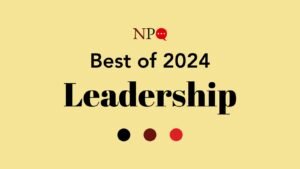
Editors’ note: In this interview, nonprofit governance expert David Renz points out that it is not enough to “manage” risk; rather, modern nonprofit boards must learn to welcome and become intimate with it, because our work in this sector has risk embedded at every level. And while many think of risk in predominantly financial terms, there are any number of risks we take that are born of omission rather than commission. Renz is the Beth K. Smith/Missouri Chair in Nonprofit Leadership and the director of the Midwest Center for Nonprofit Leadership, an education, research, and outreach center of the Department of Public Affairs in the Henry W. Bloch School of Management at the University of Missouri-Kansas City.
This article is reprinted from the Summer 2017 edition of the Nonprofit Quarterly, “Nonprofit Graduation: Evolving from Risk Management to Risk Leadership.” It was first posted online on July 18, 2017.
The Nonprofit Quarterly: What is it that you think nonprofits bring to questions of risk that is not unique to them per se but more prevalent among nonprofits than for-profits?
David Renz: Your question implies something that deserves to be overtly acknowledged: that the dimension of risk is more complex, multidimensional, and even (in some ways) more dynamic for nonprofits when compared to for-profits. This complexity derives from the foundational element of nonprofit existence: that nonprofits exist for the purpose of social impact and the creation of social value, and therefore that there are multiple dimensions of risk management and even “risk governance” to which savvy nonprofit boards and executives are attuned. Flowing directly from this is the reality that nonprofits have to be and generally are more sensitive to the perspectives of and competing tensions posed by the diverse and divergent interests and expectations of different stakeholder communities. These expectations exist with regard to actually meeting key stakeholder needs, but also with regard to how they go about addressing those needs and interests. They cannot afford to ignore the expectations of certain stakeholders just because they are less relevant in short-term financial terms.
The for-profit world is moving in that direction. Companies like United Airlines have discovered that many of their stakeholders actually care whether they drag a physician off an airplane, or other behaviors like that. But that degree of exposure and character with stakeholder audiences is especially significant to the nonprofit community—although, I must say that the nonprofits with which I work tend not to perceive or discuss such matters as matters of risk, even though they fundamentally must be understood and addressed as such.
Nonprofits are, I find, more inclined to consider and act on certain aspects of risk that they share with for-profit organizations—issues around the need to shore up eroding business models and revenue streams, and danger that the market-place will “move out from under them” when it comes to key clients’ or funders’ inclinations to remain clients and fund or pay for services. And neither sector, to me, seems to be appropriately attuned to the multiple and complex dimensions of risk associated with employment and talent—although nonprofits, of course, must also weigh human resources issues for both paid and volunteer talent.
NPQ: In your observations and reading, what particular characteristics of the way that non-profits approach and assess risk questions have you noted? Are they enthusiastic about them? Do they ignore questions of risk until they find themselves injured by the side of the road?
DR: With some notable exceptions, I think the entire construct of risk has been missing from most nonprofit organization governance and management deliberation. By and large, most nonprofits have just not given it much thought—and that’s particularly true when you think about boards and the governance end of the risk discussion. I think there is a general tendency to be risk averse because it is perceived to be safer—and frankly, I think that too many nonprofit boards tend to look at risk only from a fiduciary perspective. This certainly is necessary but is just not sufficient. And, when I say fiduciary, in this case I’m drawing from the governance categories described in Chait, Ryan, and Taylor’s book Governance as Leadership, where they sort out three types of governance: generative—that is, fundamental questions about where and how we exist to serve, leading to judgments about purpose and mission; strategic—which asks how we best proceed in the direction we discern is most important; and fiduciary—which is about how we ensure that our assets and resources are stewarded and deployed in the most cost-effective and safe manner.1 There are strategic and generative dimensions to risk that I think are not generally even perceived, much less addressed, by a typical nonprofit management team—and definitely not by a typical nonprofit board.
NPQ: We do tend to think of risk in a preventative way rather than in a generative way—can you talk a little bit about that?
DR: Yes, the imperative here is to embrace risk leadership rather than just risk management. The question is, are we taking the most appropriate risks our constituents and stakeholders deserve from us, as well as engaging in an appropriate level of fiduciary care? I think issues exist with regard to risk in all facets of nonprofit organizational strategy as well as operations, even though nonprofits often do not recognize this. At the mission and strategy level, especially when it comes to programming, I think the risk-averse—and, frankly, risk-agnostic—character of board behavior leads organizations to continue operations in program areas beyond the time when they are really delivering the greatest value to and for the stakeholder and client communities they exist to serve. There is less perceived risk in being slow to act to make change; organizations seem to think it’s safer to make the move to new and different kinds of programming—innovative and entrepreneurial new strategies—only when it’s extremely clear that such change is necessary and well advised. But the risk is that of mission performance. You may well be short-changing your clients in a world where the changes in client need warrant earlier and more dramatic changes in programs and services.
There are some other areas, too. One to which I’ve recently given more thought (and from multiple perspectives) is risk with regard to leadership at both board and executive levels. For instance, there are boards that don’t achieve an appropriate degree of diversity and inclusion, that are not engaged in systematic thoughtful board development (including bringing new members and officers on)—that are, in fact, accidentally or unknowingly choosing what may seem a less risky course. But at what price? Particularly since we know from some recent research that improved board diversity, if inclusion goes with it, tends to be associated with better program performance. And with respect to risk at the executive leadership level, at core is the risk of experiencing unplanned or poorly planned succession strategies—a growing issue in a time when there’s more and more attention around sustainability and performance. I think a good share of nonprofits and their boards prepare for succession largely from the point of view of emergency intervention or succession (such as if an executive becomes ill), yet the greater risk lies in failing to be more systematic and long term in one’s orientation toward growing and developing the next generation of executive as well as board leadership—leaders prepared to keep the organization moving even when something goes awry.
NPQ: What you’re really making is a distinction between the more obvious and somewhat immediate categories of risk—where you say, well, these things might happen if we ignore, say, overdependence on a funder or a risky political situation—and this whole other category, where you just kind of ignore your context and don’t respond to it properly.
DR: Yes—partly because we’re often operating in that mode in the belief that the context is not changing very much. I don’t meet anybody who thinks it’s not changing at all, but the sense that it’s not shifting very much leads to a false sense of security. And one of the things I find interesting is the sense that in our society—and therefore among those who serve on our boards (and some executives)—we are choosing between risk and no-risk options, as though there is a risk-free alternative. So the more relevant concerns are: are you preparing to address the risks that could be problems, and are you preparing to take the risks that might position your organization more effectively and successfully for its next generation of service?
NPQ: To what extent do you think the revenue models of nonprofits drive this excess of caution?
DR: I think they do drive it, but the irony is that as today’s revenue models tend to lose their relevance, it’s a sort of eroding foundation for many nonprofits—they don’t have the sensors in place to even perceive an impending change until it gets later than it really should. They get this sense very late—and, too often, too late to act to save the organization or program. And the time cycles for such change are getting shorter and shorter. I think with legislative and policy environments as they currently are, the danger of context shifting more dramatically and more frequently is more common—and significant, too. So, one of the elements of risk in my opinion—not solely my opinion, of course—is delay or failure in responding. And this accidentally positions an organization for an even riskier course, including staying with the business model that’s worked for a long time yet no longer is viable, even in the fairly immediate future. When it comes to hidden dimensions of finance, I love Clara Miller’s article on capital structure;2 well, for risk, I think there’s a comparable notion of risk structure to be considered, as well.
NPQ: So, in terms of how boards can take on a risk in a more structured and more complete way, what are the questions that they need to not only be asking themselves but also have a real appetite for? Because part of this is simply about the appetite for questions that bring you out to the edge of your practice, right?
DR: Right—although I do think that it actually begins at a simpler level, which is helping boards to begin to give regular thought to risk and to think about it in a somewhat more substantive and sophisticated way, so they become more open to the kind of conversation that I think you describe with your question. It’s not necessarily apparent. One of the phrases that my students regularly throw at me now when we talk in class about risk, is, “So, that’s a thing?” Similarly, I think many boards don’t get that risk is “a thing” in the nonprofit world, and that they do have a risk profile, regardless of whether they’ve intentionally chosen it or not.
So, we need to regularly host discussions about risk, starting with beginning to reflect on what is the nature of the risk profile that an organization currently has. This offers the benefit of serving as a way to begin raising awareness and to enhance sensitivity while exploring some of the simpler risk questions. It’s not necessarily going to get you into the deeper generative questions, but at least such introductory dialogue gets a board into some of the strategic kinds of thinking that, frankly, every strategic planning process should be paying explicit attention to. I believe that strategic planning typically does this, if it’s done thoughtfully. But, too often, the processes that I’ve observed do not include this, because boards see such reflection or assessment as quite superfluous or extraneous. Some leave it to management, mistakenly considering it to be a management or operations matter. There are parts that are operational, but they flow out of the choices at the strategic level.
The reality is, a lot of folks are still trying to come to grips with the notion of generative thinking. And, in a rapidly changing societal environment—and as the ecosystem continues to shift in more frequent, dramatic, and complex ways—it ought to be and usually is informing the strategic planning process. Further, planning is often happening in shorter cycles, sometimes less elaborate and formalized yet more real time and dynamic—and this is reflective of risk in the environment, too.
As I alluded to earlier, it is common for the discussion of risk to come up only when it’s associated with risk that I associate more with for-profits. A key example is when an entity is considering creating an earned-income venture. Then it starts to act a little bit more like a for-profit enterprise and think about risk in that context. But, of course, the danger may be that the real risk will be to undertake an earned-income venture that is inconsistent with the general mission, vision, and values of the organization, and will alienate stakeholders—yet the organization does not get it. The board and top executives don’t even perceive that they’re crossing that boundary until the community or some group of key stakeholders makes an issue of it. And that can be expensively late.
NPQ: There are so many aspects to risk: reputational risk, cash-flow risk, risk of an act of God. And there are so many ways to approach the question of risk. How do you think boards generally need to be set up to ask those “what if?” questions that organizations very rarely address unless they’re larger?
DR: I really do believe that it makes the most sense to couch them in terms of strategic direction, because if we exist to meet the needs of a segment of our community—certain groups of stakeholders—then, as we consider how well we’re meeting their needs and how their needs are shifting and evolving, a logical complement to the process of developing options and exploring options is to consider what aspects of risk are associated with those options. The reason I tend to encourage folks to think about the concept of risk before they start making those particular judgments is because—somewhat analogous to coping with ethical questions—when you’re in the middle of trying to weigh options, you lose sight of the fundamentals and principles. And certainly the folks who advocate for more effective risk management and even “risk governance” are pushing people to recognize their general risk assumptions. I go back to the concept I used earlier: the risk profile. What is our tolerance for risk, and what kinds of risks are more or less appropriate? And I think the answers to this can grow out of a stakeholder discussion that informs strategic planning and is at the very beginning of a process, even growing out of that generative conversation. Sometimes I think it might be funny, in a perverse sort of way, to actually start a planning discussion with a board by asking its members to answer the question, “What are all the risks that our organization has been taking that are ill advised?” Let’s just try to get them to begin to think about that. My guess is that they would not be able to think of many of the risks.
NPQ: Those that are most looming….
DR: And that are even potential. I mean, anything with regard to assets has a risk dimension to it. And, when I talk with boards about resources, one of the things I always tease them about is that they rarely give thought to one of the most critical of organizational resources or assets—the trust and credibility they have with their stakeholder communities, both donor and client. So, they don’t even think about that kind of potential risk problem until it’s so late that they’re fighting fires—when the discussion has shifted from strategic to urgent, and they have closed off many of the more attractive options that they could have exploited if they had seen things earlier, when they weren’t actually a problem. Sometimes the risks are appropriate and must be taken, but it’s still important to understand you’re taking them and assess the consequences and how best to address them.
NPQ: And there may be other alternatives to the course that one is taking that have either less risk or less of a payoff.
Sign up for our free newsletters
Subscribe to NPQ's newsletters to have our top stories delivered directly to your inbox.
By signing up, you agree to our privacy policy and terms of use, and to receive messages from NPQ and our partners.
DR: Yes. It’s a cost-benefit dynamic, but with regard to risks specifically.
NPQ: So, how does a board manage risk without understanding its own enterprise plan? If you don’t understand the dynamics of your own business model, how do you reasonably take on risk? Or is that really a precursor?
DR: I would say it is a precursor, because business models are so integral. Again, it’s like Clara Miller’s notion of capital structure.3 There’s an inherent risk structure in the design of one’s business model; there’s an inherent risk profile built into one’s organizational structure. Bob Herman and Dick Heimovics wrote a long time ago about board-centered executive leadership—about how important it is for executives to prepare their boards to lead rather than assume they are ready to do so.4 I think risk is another category where expecting board members to arrive prepared to weigh decisions in any kind of a substantive way—much less a sophisticated, environment-changing way—requires support from the organization and top executives. Now, those of us at nonprofit academic centers and other capacity-building programs could do more to help boards and board members prepare, in principle, to think in more productive and sophisticated ways about this. But what I’ve observed is that it’s hard to think about these things in principle. Until board members are actually enmeshed in a situation where there is a real risk problem or threat to consider, it’s hard to conceive of the nature and form of the risks. We need to start helping boards to do this, and to do it better.
NPQ: It’s a funny thing to have neglected all this time.
DR: Yes, but I think it reflects the fact that historically nonprofits were less risky forms of enterprise, as a category. Certainly, there has been a lot of variation, and sometimes nonprofits just didn’t recognize it. But I think the nonprofit operating environment was more forgiving forty or fifty years ago for many enterprises, including nonprofit organizations, than is the case now and certainly than will be the case moving forward.
NPQ: When you look at what happened to all of those arts organizations during the recession—so many of them with the same profile going into crisis. It should have taught us something that is now clearly known by everybody else, but I don’t think that it has.
DR: True. And that may be another way to help nonprofits be more proactive. It may be that the associations and advocates for particular mission categories (for example, various membership groups for an industry or field like the arts) help lead. Maybe that’s one of the places to start to raise awareness, because you can be a little more specific about kinds of risks that would be common or even logical, when you are specific by mission category. Nobody is confused about the fact that the nature and forms of risk are completely different for the Red Cross blood system versus a community museum.
But, again, I think it’s partly a matter of helping people begin to get their heads around this topic and to try to do so before there’s a crisis. As I said earlier, it’s very tough to think your way through it when it becomes a matter of crisis.
In fact, part of the proactive side of this is to even identify what the kinds of risks are that might be most likely to jump out at us, and have that discussion with the board. To consider what some of the most important categories are. To do a little scenario thinking, and weigh the degree of risk that we really think is there. The idea of emergency succession planning for executive directors reflects that orientation, but it tends not to have been a very systematic practice. Emergency succession just happens to be one particular category that boards have been more aware of.
NPQ: Do you have anything else you’re driven to say about this topic?
DR: Boards need to be in the game from the start. They need to be risk savvy—to be systematic and thoughtful—before it becomes an urgent or emergency issue.
NPQ: It is like that piece of research that Rikki Abzug and Dennis Derryck did a while ago, after 9/11, which described how organizations that were more connected—that were more networked—were better able to access the information quickly, even under the most difficult of circumstances. And their constituents were better served as a result.5 And it’s interesting because we know that understanding the business plan has got to be a good precursor of risk assessment and management—but perhaps being networked and understanding what’s coming down the road is also a precursor.
DR: I think it is. Another facet I have been thinking about is that being networked helps you develop or sustain resilience in times of threat. And it’s something we see illustrated in individual communities when people realize they need to help each other in times of crisis—such as when a tornado knocks down a town and we come together and try to help each other. Well, even though nonprofit groups experience a completely different category of risks and problems, the same is true, I believe, for nonprofits.
I have to add a completely different element, too. Another kind of driver that’s independent of the specifics of boards is the non-conscious dynamics of group process. When groups engage in decision making about group choices associated with risk, they’re making choices that actually get amplified in one direction or another from what the participating individuals would be inclined to choose on their own. And in the early days the research was overly simplistic, and it simply said that groups, when they come together, tend collectively to choose a riskier course of action than would be the case when individuals are confronted with that same decision situation. The research subsequently has become more nuanced, and what social psychologists have figured out is that the direction of the risk is in fact a matter of whatever is the cultural tendency for that situation or environment. The degree of risk selected is amplified when a group of people come together to decide. So, if your tendency would be (and this may be why we sometimes see a lack of thinking about risk) to avoid risk or think that risk is not an issue, then when we collectively come together we’re even more inclined to reinforce that risk-aversion or risk-ignorance dynamic. And it’s the non-conscious stuff that plays out in some pretty unintended ways.
Further, I think this dynamic has a real relevance when you’re thinking about innovation—nonprofit innovation, or nonprofit efforts at entrepreneurial or socially entrepreneurial thinking. We need to start by understanding the implicit values built into the decision. This is relevant to questions of board composition and diversity, and it’s important to think about, because when you bring a group of individuals together as a board, it’s the cultures and the sorts of risk heuristics of the folks who have come together on that board that will be amplified in one direction or another. So, if you have a board that is not particularly diverse and that doesn’t understand the full range of decision making and issues and challenges confronting the organization, you may see these dynamics lead to suboptimal decisions just for that reason—and it’s not that people are even making choices so much as they’re just following a path that’s almost automatic for them.
NPQ: That’s interesting, because if you think about that in relationship to creating boards that are more inclusive, it makes perfect sense. It’s already a culturally reinforced group, and it becomes more and more impossible over the years to actually get through the various protective measures that it has.
DR: That is important to think about, too.
NPQ: Yes, it’s certainly a scary notion.
DR: And another of those sometimes amusing group dynamics that many have come to know is the so-called “Abilene Paradox,” the theme of which is: how is it that groups at times come together to select a course of action that none of their members individually thinks is even a good idea? So these two aspects of group dynamics—the issue of the “choice shift” and the Abilene Paradox—can help explain why we sometimes end up making decisions about risk for reasons that are completely irrelevant to the substance of the options, and maybe even choose a course of action that none of us thinks is sensible.
NPQ: We’ve seen this happen on boards playing with the idea of buying a building, and the way they’re making the decision becomes completely irrational but is driven by something that is more powerful than any caution.
DR: It’s real.
NPQ: It’s real, but you know you don’t know what it’s really made of.
DR: Right. And for those who want to believe that truth inherently derives from group involvement, you have to be careful; group process that is ineffectively supported and facilitated isn’t always going to reflect truth and insight. It can go in many different directions.
For me, the bottom line is that there is a myriad of elements that combine to affect how well a board and its members address the issue of risk in the governance of a nonprofit organization. Some are the result of varying levels of knowledge, experience, and overt attention that boards and their members bring to the consideration of risk and what is warranted and appropriate for their organization; and some are the result of seemingly irrelevant factors, such as group and interpersonal dynamics. And they all affect organizational effectiveness. It’s time for executives and boards to consider how to more fully and effectively prepare boards to engage in the increasingly important work of risk leadership as well as risk management. Our organizations’ futures depend on doing this well.
Notes
- Richard P. Chait, William P. Ryan, and Barbara E. Taylor, Governance as Leadership: Reframing the Work of Nonprofit Boards (Hoboken, NJ: John Wiley & Sons, 2004).
- Clara Miller, “Hidden in Plain Sight: Understanding Capital Structure,” Nonprofit Quarterly 10, no. 1 (Spring 2003).
- Ibid.
- Robert D. Herman and Richard D. Heimovics, Executive Leadership in Nonprofit Organizations: New Strategies for Shaping Executive-Board Dynamics (San Francisco: Jossey-Bass, 1991).
- Rikki Abzug and Dennis Derryck, “Lessons from Crisis: New York City Nonprofits after September 11,” Nonprofit Quarterly 9, no. 1 (Spring 2002).












